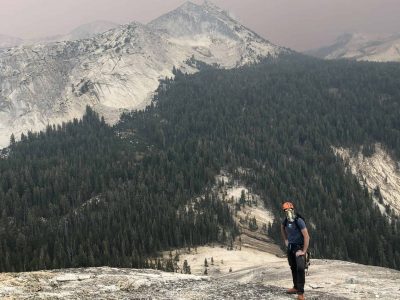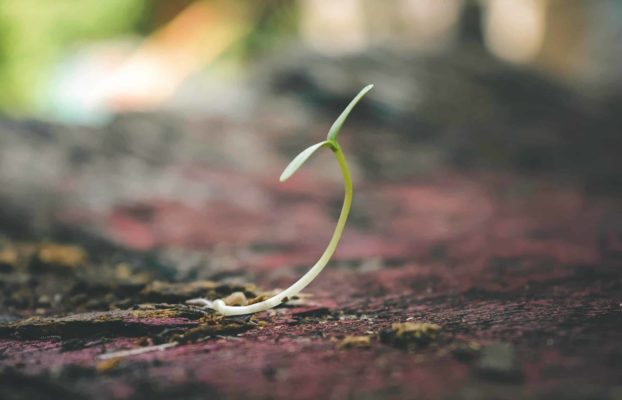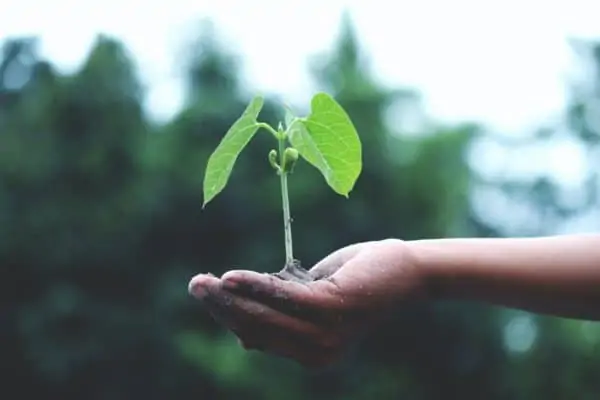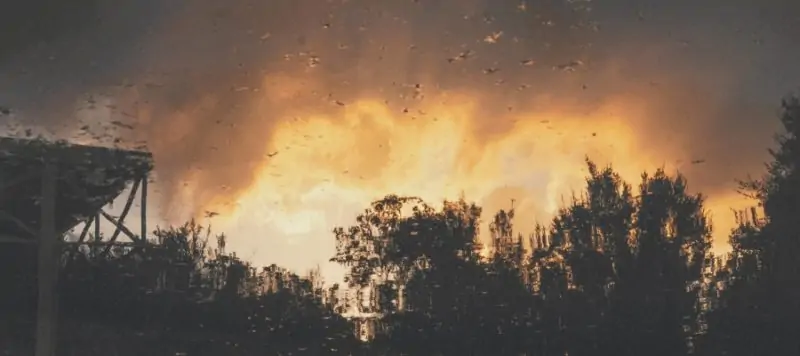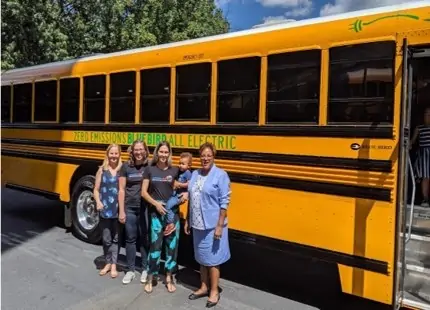WHEN I’M NOT MANAGING THE SUSTAINABILITY PROGRAMS AT UCLA HEALTH, my friends and colleagues alike know where they can find me: out of cell phone range, in the mountains, rock-climbing. This hobby (bordering on obsession) enables me to disconnect, breathe, and unclench my jaw—which, admittedly, felt like it was perpetually clamped down in 2020.
You may not agree that being hundreds of feet up on granite walls could be relaxing—and to be sure, at times it’s not—but overall it’s the best stress reliever I’ve found that helps me focus on the present moment while testing the push-pull balance between confidence and fear.
Toward the end of last summer, my climbing partner and I headed to Yosemite with high ambitions for the Labor Day weekend. Just after sunrise on the first morning we set out to climb Fairview Dome, a towering 643 ft. granite feature in Tuolumne via the “Lucky Streaks” route. It was a beautiful California day and each pitch we climbed seemed better than the last. It took us five hours or so to reach the summit, but as we started our descent the wind picked up. The gusts increased in intensity, and the bluebird skies overhead turned apocalyptic as dark smoke moved in from several wildfires in the surrounding area. Because of the ongoing pandemic, we had face masks with us. We put them on and as we reached the base we realized our holiday weekend plans were now rendered impossible by the smoke engulfing the Sierras from Sequoia to Mono Lake and beyond.
Come to think of it, there may be no better metaphor for the interconnectedness of today’s COVID-19 and climate change crises than our masks filtering out both ash and pathogens simultaneously.
The 2020 California wildfire season shattered previous records, as nearly 10,000 fires burned more than four million acres—over 4% of the state’s land. One of my colleagues saw their homestead in Santa Cruz reduced to ash by wildfire. Poor air quality from the burning of fossil fuels and ash can lead to pulmonary and cardiovascular morbidities, which also increases the likelihood that those affected could suffer severe symptoms if they contract COVID. The pandemic is inextricably linked with the climate crisis, and entwined with both are the manifestations of racial injustice that exist in our country.
The pandemic has accentuated the many ways that Black, indigenous, and people of color (BIPOC) carry a disproportionate burden of adverse health effects in our communities. Just looking at research done by C-Solutions in the last year, we know, for example, that BIPOC populations are disproportionately exposed to oil and gas flaring—the burning of waste gases during the drilling and oil production process, which releases toxic air contaminants and have been linked to higher preterm birth rates among Latina women. Sometimes the link is even more direct, as C-Solutions researchers found that Los Angeles County neighborhoods with the worst air quality have the highest death rates from the pandemic. And other research shows that a hotter world and one with less biodiversity increases the likelihood we will see more pandemics, potentially even more dangerous than the current one.
As I write this, I can see the light at the end of the proverbial COVID tunnel as millions of people stand in line to receive their vaccinations. But climate change isn’t going anywhere. Although the pandemic brought a welcomed decrease in global carbon emissions in 2020, a new study has shown that both Arctic and Antarctic sea ice melting rates now match the IPCC’s worst-case scenario for warming. As we try to “build back better,” we need to recognize that a return to business-as-usual is unfortunately looking more like a worst-case scenario.
So how do we avoid this? As individuals, there’s a lot we can do to make a positive change. It starts with encouraging the leaders in our workplaces to adopt zero-carbon and efficiency policies that eliminate wasteful practices. We need to examine our workflows and purchasing choices, and embrace change management programs that help our organizations get to zero carbon on science-based timelines. We have to demand accountability from our local, state, and federal representatives as well. Our government needs to dramatically increase energy R&D and utilize its procurement power to increase demand for green products while driving down their premiums. It needs to put a price on carbon to account for the true cost of fossil fuel production, factoring in the damage to the environment and to the public’s health. And it needs to make massive investments in infrastructure like high-voltage power lines to connect the best areas for solar and wind development to the grid, increase clean fuel and electricity standards, and develop jobs programs to ease the transition.
In my own work, I often speak about sustainability issues in front of doctors, nurses, and students who are the next generation of clinicians. I like to remind them that healthcare professionals are consistently ranked among the most respected professionals by the public. Just as they have more than stepped up to meet their responsibility during the pandemic, they must also step up and advocate for our patients and communities. In their interactions with patients, they can help connect the dots between planetary health and human health. In my view, there is no one better to convey the message.
When I’m climbing, confidence drives my optimism—and fear, my pessimism. With regard to climate change, I fear that humanity’s “lucky streak” is rapidly coming to an end and we’ve procrastinated too long on solving the problem. But if I let my fear control me on a rock face, it can have a paralyzing effect. Similarly, we can feel paralyzed in the face of climate change, which can lead to inaction. But we already have many of the tools and solutions we need to rapidly decarbonize. We need smart investment and the political will to put these solutions to work to ensure a healthy future for everyone.

